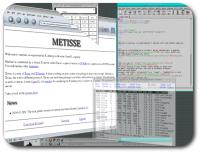
An old screenshot of my Linux box at the University.
In the background I embed sunny resorts that I once
visited and they revolve periodically, owing to KDE
 am exceedingly impressed by the innovative work of the KDE team. These folks truly invent some productivity methodologies which exist nowhere else. KDE is primarily targetted at operating systems such as Linux and BSD and it puts them both at the forefront of innovation. How they do it, I don’t know, but I suspect that requests and suggestions from the public (KDE userbase) make it a reality, via wishlist items, reported as ‘bugs’ with low severity level. Allow me to exemplify my statement using a timely realisation.
am exceedingly impressed by the innovative work of the KDE team. These folks truly invent some productivity methodologies which exist nowhere else. KDE is primarily targetted at operating systems such as Linux and BSD and it puts them both at the forefront of innovation. How they do it, I don’t know, but I suspect that requests and suggestions from the public (KDE userbase) make it a reality, via wishlist items, reported as ‘bugs’ with low severity level. Allow me to exemplify my statement using a timely realisation.
Only yesterday, I needed to restart KDE (no reboots involved). This happened after over one month of this non-stop KDE session. The motive? Possibly a few memory leaks, which had accumulated throughout 5 weeks of 24/7 computing (I run experiments using untested code overnight and whenever I am absent). Either way, once restarted, KDE restores the user’s session perfectly.
All windows re-appear in the correct virtual desktop, in the same position with the same dimensions as prior to logout. A complete system reboot would have had the same impact. Shells are reinstantiated and created, possibly positioned at the same directory/path as before. While it sounds simple and trivial, it is not. File managers likewise. FTP connections are restored with the servers in question, even at the right depth and directory level. The only exception are SSH connections that were opened without calling the command directly, e.g. SSH within a shell. Otherwise, even remote connections as such are restored! Again, this should not be taken for granted.
In this older version of KDE (3.1, as haven’t tested it yet with the newer setup at home), Mozilla applications are the sole exception. They are not being restored. Nonetheless and all in all, well done, KDE team! You thought of everything the user will ever need.
There is a Mozilla Firefox extension called SessionSaver. It achieves something similar to the above by fully restoring tabs, even with textarea input re-instered. This mechanism is robust and even resilient to browser crashes, all at the expense of browsing performance, as well as some system resources.
Related recent item: Why I Love KDE

 ave a look at this astounding XGL/Compiz video (I conceded embedment of videos in page). The video demonstrates the cutting-edge Linux desktop experience (with pleasant background music). As the title of this video says, “the future is now!”; be sure to read some of the bound comments.
ave a look at this astounding XGL/Compiz video (I conceded embedment of videos in page). The video demonstrates the cutting-edge Linux desktop experience (with pleasant background music). As the title of this video says, “the future is now!”; be sure to read some of the bound comments.





 Filed under:
Filed under: 
 INUX can be assimilated to merely any desktop environment, including the appearance of its rivals’ desktops. It can endlessly adapt, particularly layout-wise, although look-and-feel is getting there too. Different interfaces (achievable through desktop environment), as well as various addons, make this truer than ever before. There are several design sets lying about, which enable Linux to look and behave merely like any other operating system. Here are a few examples that I collected recently:
INUX can be assimilated to merely any desktop environment, including the appearance of its rivals’ desktops. It can endlessly adapt, particularly layout-wise, although look-and-feel is getting there too. Different interfaces (achievable through desktop environment), as well as various addons, make this truer than ever before. There are several design sets lying about, which enable Linux to look and behave merely like any other operating system. Here are a few examples that I collected recently:
 HE admirable
HE admirable 
 UITE often I rave about KDE, as I last did
UITE often I rave about KDE, as I last did  ESTERDAY I took a quick tour through some mockups and proposal made for the KDE project. I would like to present three examples, which are merely screenshots, sometimes combined with art work.
ESTERDAY I took a quick tour through some mockups and proposal made for the KDE project. I would like to present three examples, which are merely screenshots, sometimes combined with art work.
 am exceedingly impressed by the innovative work of the KDE team. These folks truly invent some productivity methodologies which exist nowhere else. KDE is primarily targetted at operating systems such as Linux and BSD and it puts them both at the forefront of innovation. How they do it, I don’t know, but I suspect that requests and suggestions from the public (KDE userbase) make it a reality, via wishlist items, reported as ‘bugs’ with low severity level. Allow me to exemplify my statement using a timely realisation.
am exceedingly impressed by the innovative work of the KDE team. These folks truly invent some productivity methodologies which exist nowhere else. KDE is primarily targetted at operating systems such as Linux and BSD and it puts them both at the forefront of innovation. How they do it, I don’t know, but I suspect that requests and suggestions from the public (KDE userbase) make it a reality, via wishlist items, reported as ‘bugs’ with low severity level. Allow me to exemplify my statement using a timely realisation.